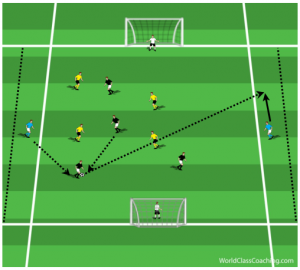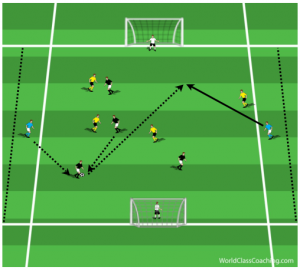By Sean Pearson
Area Size: 40 x 45 Yards
Teams: 6 v 6
Time: 20 Minutes
Objectives
- To understand when and where to play the long pass
- Use the correct weight of pass
The area is split into three zones, two wide zones of 5 yards in depth and a larger middle zone of 30x45 yards. There are 2 neutral players in the wide zones (1 each). The aim is understand when to play a long ball, in the air, diagonally across the field to the neutral wide player. During a game this wide player could be either a wide midfielder/striker or a full back. A player who is probably the best in the world at this type of pass is Steven Gerrard. But he had to develop it. In today’s game we take a lot from possession based clubs like Barcelona and Bayern Munich and the football/soccer purists would have every pass on the ground. However Bob Paisley, Liverpool’s manager from 1974-83 winning 3 European Cups and 6 league titles, once said ‘its not about the long ball of the short ball, its about the right ball’.
For myself, I take a lot from this quote. I see football/soccer as a game with more than one answer and more than one way to play. Players only get better with good practice, to not teach a player how, when, where and why a long pass is useful is doing a disservice to them. If you can add another string to your team’s offence then why not take it.
This small sided game is based on using a long diagonal pass to advance your team up the field, due to pressure on one side. Rather than always switching the ball from side to side methodically from player to player a better tactic is to switch the ball quickly. For instance if you ever play against a 4-4-2 diamond they will most likely have more players in the middle but are underloaded down the wide areas. One tactic to use would be to switch the ball as quickly as possible to the weak side and attack their full back with both your wide midfielder and full back for a 2 v 1 scenario. The only way to do this quickly enough would be to play the long diagonal pass.
Set up both teams in a 2-1-1 formation but both can use the neutrals for their width. When one side gets too congested, a defender drops backwards to allow them more room. The pass to them can come from anyone but they can see the space on the far side of the field. A lofted ball with the laces it aimed in front of the wide midfielder so the ball is further up the field. From here you can say the neutrals have to stay in their zone or they can enter to middle zone, I would go for the latter as it is more game realistic.
If opposition begin to cheat and start to drift wider to stop the pass, the space is now in the middle of the field, encourage your wide players, if they see this to come in off the line. The pass must again be aimed in front of where the wide midfielder is. Once controlled they are live and if they can should be encouraged to shoot on goal.
Coaching Points
- Technique of pass
- Decision of when to play the pass
- Direction and weight of pass
By Sean Pearson. Sean is also the author Coaching Team Shape in the 3-3-1, Coaching Team Shape in the 4-2-3-1 and Coaching Team Shape in the 4-3-3




